Chapter 3
Picking the Best Camera for Your Needs
In This Chapter
![]() Knowing your camera’s intended use
Knowing your camera’s intended use
![]() Determining how much weight your drone supports
Determining how much weight your drone supports
![]() Choosing a digital camera
Choosing a digital camera
![]() Comparing features and price
Comparing features and price
As you search for your perfect drone, you will quickly see that there is an increasingly vast array of options. You want to consider the drone’s power and the distance it will fly before its battery requires recharging. You want to research its controls, look, and feel. And if you decide to purchase a drone that does not come with an integrated camera, you will have to make another difficult decision: what type of camera will you purchase?
This chapter helps you make an informed choice of camera and camera accessories. It’s okay if you haven’t decided whether to purchase a drone with or without a camera. This chapter will likely push you over to one side of the fence.
In this chapter, you navigate a number of uses for your aerial camera rig specifically to help you narrow down how you most commonly intend to use your drone and associated camera. You see the major differences between DSLR cameras and action cameras before diving deep into the nitty-gritty features that make each camera type suited for a specific use. Then you explore the capabilities of each camera category by looking at their features and how those features will help you achieve different results.
Last, and definitely not least if you are cost conscious at all, this chapter will be beneficial to you in that it will help you identify a camera that has the right amount of power and features at the right price. Purchasing your drone and camera is an investment no matter how you slice it. You are either investing in a creative outlet or you are investing in your business. Making the right purchase will maximize the benefit you receive.
Knowing How You Will Use Your Camera
Cameras that have many features and capabilities can cost more, even much more, than their simpler counterparts. While money may not be an initial driver in your decision-making process, you will find that cost can, and will, spiral out of control very quickly. Your best bet is to identify a camera that neither exceeds nor falls short of your needs. To find an ideal match, you must assess how you will use the camera with your drone.
To help determine how you intend to use your camera, consider the following:
Determine whether you will be using your aerial photo/video rig primarily for hobby, or if you will be using it professionally.
Hobby uses and professional uses can look identical depending on how seriously you take your hobbies. A personal assessment of need versus want combined with disposable income will help you make a decision on the level of features and investment you should make in your camera gear. Determining this balance is difficult for hobbyists because the decision is far more emotional than it is mathematical. Selecting gear for a professional application is a little easier because you can strip away the emotion to make a decision that is driven by dollars and sense.
Determine whether your core use is for photography or video.
Most digital cameras that are designed for photography can capture video, and many of the digital video cameras have the option to capture stills. That said, if you want to take spectacular photos, you need to focus on cameras that can capture great photos. If you have some video needs, then a camera with video capabilities as a secondary feature may suffice. The same goes for video. If your primary use will be to capture video footage, focus on a camera designed for video. Pulling still photos from video footage isn’t ideal because it is tedious, but it is possible. Some video devices may also have photo capabilities as well.
Consider where your video or photography will be used.
How will your finished work be used? Will you be printing photos in publications or to be framed and hung on the wall at home? Are you making videos to play on your smartphone or will it be for your ultra-high-definition television at home?
Where and when will you capture the majority of the footage?
If you plan to capture videos and photos outside, then you need to decide whether or not you will be working in the elements. Will you have to work in the rain or snow, extreme temperatures, sandy or dusty air? If so, you will need to look for a camera that has options for handling these environments. If you plan to work with low-light much, you will want to ensure that the camera you choose works well in low light.
Determining What Your Drone Supports
If you haven’t purchased your drone, then the best place to start looking is on the drone manufacturer’s website. Identify which drone you are interested in and then navigate to the product specifications list. This should include information on the type of camera or cameras the device supports. Most drone manufacturers are quite explicit on the type of camera they support. However, if you cannot find any information online, you should look to see if the drone supports a gimbal. Gimbals are special camera mounts that can provide a range of features, such as image stabilization and camera directional control. Gimbals are typically made for a specific type of camera. Therefore, knowing what gimbal your drone supports will help you narrow down to the types of cameras you can use.
If you have already purchased a drone, then you should refer to your drone’s owner’s manual. The manual contains information on the type of camera your drone supports along with how to attach it to your drone. If you’re like my friend Colleen, chances are good that you will lose your owner’s manual. The good news is that most popular drone companies like DJI, Parrot, or 3D Robotics have online versions!
Weight Is Everything
There is a direct correlation between size of the camera and total price of your aerial imaging gear. The reason for this is that the bigger cameras require more robust mounting equipment and all the extra weight means that the drone needs to be more powerful to be able to get it off the ground. Like all aircraft, drones are a careful balance of propeller size, motor strength, battery power, and total weight.
The heavier the aircraft, the more air that must be moved to achieve weightlessness. Figure 3-1 shows a heavy duty drone and camera rig.
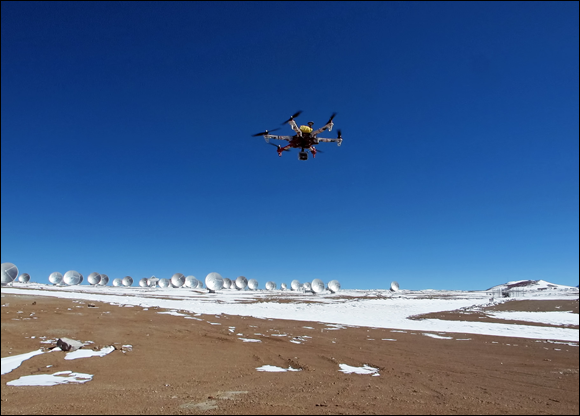
Source: European Southern Observatory (ESO)/ Creative Commons.
Figure 3-1: A massive drone and camera rig.
You can do this by merely spinning your propellers faster, but propellers can only go so fast before centrifugal force causes them to become turbulent and unstable. The other option is to just use larger propellers so that you displace more air per revolution. Larger propellers, however, are heavier and with the increased surface area, increased resistance occurs, which means you need a more powerful motor. When you add a more powerful motor, you have an increase of total weight from the motor and rotor and you have an increase in power consumption. More power consumption means that you will need a more powerful battery and as batteries go up in output and capacity, they go up in total weight. Larger propellers also require greater clearance between each other.
Because of these factors, you will typically see larger and heavier camera equipment supported by drones with six to eight rotor/propellers, like the one shown in Figure 3-2, which shows an octocopter (8 rotors). More propellers means more air displacement which equates to a greater lift capacity. As you can tell by Figure 3-2, these craft are quite a bit bigger than the tri and quad copters that support smaller action cameras.

Source: Service-drone.com
Figure 3-2: Octocopters have 8 propellers.
Digital Camera Technology
Camera technology has come a long way in the past 25 years. So far, in fact, that film photography has become something reserved for film purists and nostalgia. Some would argue that film is still far superior to digital photo much in the way that music purists argue that records are far superior to digital media. In a way they are probably right, but it really is hard to tell the difference these days because digital technology has advanced so far.
Film cameras and digital cameras function in a very similar manner. When taking a picture with a film camera, a shutter opens for a brief moment to allow in light. The light is then focused and reflected onto a piece of film. The film captures the image exactly as it was seen through the lens of the camera. When a roll of film is developed, the film is chemically treated so that it is no longer reactive to light. The end result is a negative, a transparent piece of plastic that contains your image. Shine a light on your negative to project an image onto a screen or onto a piece of paper to make a photo.
Digital cameras function much in the same manner. A shutter opens to allow in light through the lens. The light is then focused and reflected onto a sensor instead of a piece of film. The sensor then translates the light information into pixels, which are organized and stored in a digital file. Digital video works much in the same manner as digital photography.
With so many digital cameras available, you have many features to choose from. If you are interested in learning about those features in depth, see Digital SLR Cameras and Photography For Dummies (Wiley).
Aside from price, here are the primary features that require consideration when selecting your new camera:
- Sensor size and type: Digital camera sensors capture the image information and convert it into a digital image. The two primary sensors that are widely used today are CMOS and CCD sensors. There is some debate over which sensor type is the better option, but really, sensor size is the more important consideration. The larger the sensor means the greater the image information that can be captured. Figure 3-3 shows a digital camera sensor.
- Lens: Your camera lens gathers and focuses the light that makes up your picture. Several types of lenses are available that create different effects. Maybe you want a close-up shot that is very focused, or maybe you want a distant that is clear as can be. Different lenses serve these different purposes. Having the option to change out your lenses to perform different functions is a huge plus for professional photographers and videographers. Integrated lenses are cheaper and they are typically designed to work in numerous scenarios; however, the saying goes “A jack of all trades is a master of none,” and the same goes for integrated lenses. Figure 3-4 shows several types of lenses.
- Image processor (file types): Once an image is captured by the sensor, it must be converted into a digital file. Your camera’s image processor compresses the image into a variety of different file types. Keep in mind that the term compress is synonymous with “throwing away potentially useful image information for the sake of saving space.” Shooting in RAW is the only way to not lose image information. RAW is essentially everything that your image sensor detects. RAW files take up a lot of space, about two to three times more than a comparable JPEG, which is why an image processor is valuable. Compression also means that you need fewer SD cards for storing your images.
- Image size: Camera companies have been using megapixel ratings as a marketing gimmick for a long time now. Debating megapixels is like debating Nikon and Canon. Pixels are used to describe the size of an image, not the overall quality of the image. More megapixels means the bigger your prints can be. Thanks to today’s technology, we can make an 80-foot-by-20-foot print of my mother. Bottom-line, the larger the megapixel rating, the better.
- Video options: Every camera today should come with the option to capture video. DSLR cameras and point-and-shoot cameras, for the most part, have a video mode that allows you to capture video footage. You may want to pick a camera that has video capability, whether you think you’ll use it or not. It’s a great feature, even if you don’t intend to use it frequently.
- Video resolutions: Video resolution has to do with the number of horizontal lines (and corresponding vertical lines depending on the video’s formatted aspect ratio). For instance, if you are viewing something in full high-definition, then you are viewing an image that is made up with 1080 horizontal lines of picture information. The higher the definition, the crisper and more vibrant the image should appear on your display device. If you are interested in video, you want to make sure that the video capabilities of your camera are at minimum HD. Some cameras will capture ultra-high-definition, which means higher than HD. 2k is essentially 2 times the definition of HD; 4k is 4 times, and so on. Figure 3-5 compares the different video resolutions.
-
Frame rates: Video is a sequence of photos. There is a lot of debate on how many pictures the human eye and brain can process per second, but the industry standard has been 24.7 frames per second for a long time. That means that in video, you show 24.7 pictures per second to make the video look smooth and buttery. However, cameras today can capture video at higher frame rates which means more pictures per second and ultimately, an even smoother looking video.
 An added benefit to higher frame rates is smooth slow motion. If you were to slow down a video shot at 30 frames per second, it would look and feel like a family slide show. However, if you shot a video at 120 frames per second and you slowed it down to 30 frames per second, your video would be silky smooth and it would be moving at one quarter the speed. Imagine the action shots that would look amazing in slow motion!
An added benefit to higher frame rates is smooth slow motion. If you were to slow down a video shot at 30 frames per second, it would look and feel like a family slide show. However, if you shot a video at 120 frames per second and you slowed it down to 30 frames per second, your video would be silky smooth and it would be moving at one quarter the speed. Imagine the action shots that would look amazing in slow motion!
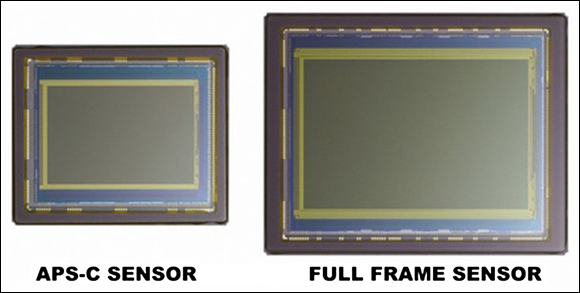
Source: Onslidephotography.com
Figure 3-3: Digital camera sensors gather light to make images and video.

Source: mecookie/Creative Commons
Figure 3-4: Lenses small and large serve a number of purposes.
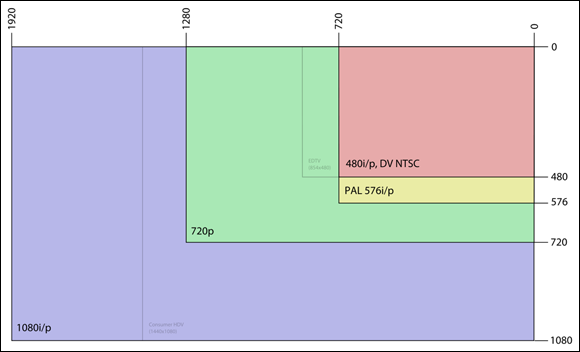
Source: en.wikipedia.org/TVaughan1
Figure 3-5: Standard-definition to high-definition.
Picking a point-and-shoot camera
Point-and-shoot cameras are small, easy-to-use digital cameras. The point-and-shoot camera is a great way to get a digital camera at a low price. These cameras were designed to take pictures without much thought (if any at all). They are great for the beginning photographer or the photographer that doesn’t really care to take the time to set up a shot. Of course, with automatic settings, you are at the mercy of the intelligence built into the camera.
Point-and-shoot cameras are also designed to be compact so that they can fit in your pocket and be taken virtually anywhere. The smaller size means that their image sensors are extremely small, which will affect the quality of your pictures. That’s not to say that you can’t take really beautiful pictures with a point-and-shoot camera. These photos will just not be comparable to the images you can take with a full-size DSLR (covered in the next section, “Deciding on a DSLR camera”).
Point-and-shoot cameras rarely, if ever, come with support for additional lenses, so you are at the mercy of the integrated lens and zoom. This is great for keeping the overall weight of your camera rig down. However if you want to get different effects that can only be produced by incorporating different lenses, you’re out of luck. Most point-and-shoot cameras have a video mode, however, which is great for having the option to capture video on a device that is designed more specifically for capturing fantastic pictures. Several types of drones support point-and-shoot cameras. To get an idea of the different types of point and shoot cameras currently available, take a look at Figure 3-6.
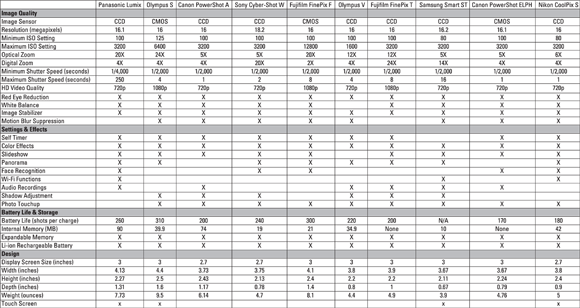
Figure 3-6: Compare and contrast point-and-shoot cameras.
Point and shoot cameras are great for capturing good quality pictures without spending too much time configuring a camera. These cameras typically come with great automatic settings that can adapt to their environment on the fly. These cameras are also light which makes them a great option for smaller drones. Point and shoot cameras are also a little more durable than their DSLR big brothers. This is a great feature when strapping them to a flying computer that could potentially fly through a waterfall, crash into a tree, or fall out of the sky. Lastly, you can’t really argue with the price. Point-and-shoot cameras are in a price range that is affordable for many!
Deciding on a DSLR camera
DSLR stands for digital single light reflex, and the term is used to categorize high-end consumer and professional quality digital cameras. DSLR cameras come with a huge range of features and technical capabilities, which is why their uses span from hobby to professional. DSLR cameras have larger sensors than their point-and-shoot little brothers. Bigger is definitely more expensive when it comes to DSLRs. Bigger sensors come at a high price point, but they also provide much better imaging capabilities.
DSLR cameras can be for the beginning and aspiring photographer. Smaller cameras still come with several manual image control features and the option to swap out images. This gives the user the ability to try different combinations of settings and lenses. DSLR cameras are much larger and heavier than point-and-shoot cameras. They are also a little more complex, which may slow you down when you are setting up your drone. Figure 3-7 shows a few different DSLR cameras with lenses.
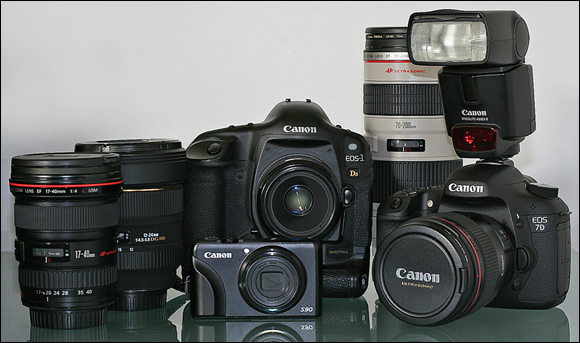
Source: Scott.Symonds/Creative Commons
Figure 3-7: A DSLR for every occasion.
While DSLR cameras were original developed purely for photography, in recent years, DSLR manufacturers started adding in video modes. This was intended to give users the option to capture some footage, but it was never intended to be the sole purpose of the camera. DSLR video footage can look so incredible, however, that video geeks everywhere have started using DSLR cameras specifically for video.
Here are just a few reasons why DSLR cameras are an appealing choice for recording video footage:
- Price point: The price point for a DSLR is much lower than video cameras of comparable quality
- Lenses: Seemingly infinite options are available for lenses
- File storage: The DSLR cameras store video footage in file format on SD cards instead of tape or the more expensive P2 cards seen in high-end pro cameras
Figure 3-8 is a picture of a video rig using a DSLR camera.
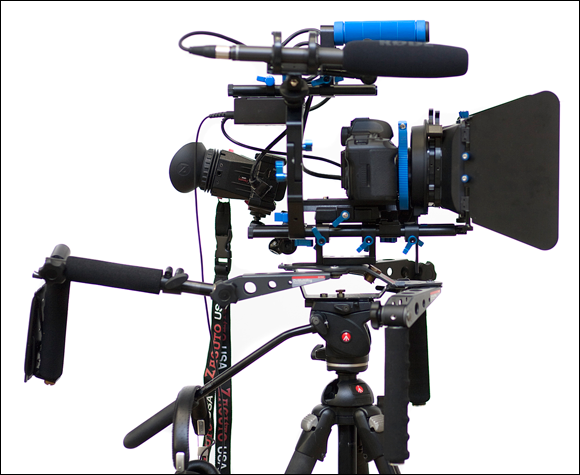
Source: Sebastiaan ter Burg/Creative Commons
Figure 3-8: DSLR video rig.
DSLR cameras are a great camera for people who are serious about photography and video. The major drawback is that DSLRs are heavier than the point-and-shoot cameras, and depending on the lens, weight and balance can become a major issue. Remember, the heavier it is, the more it is going to cost you! You are going to need a big drone to lug your high-end camera around and you are going to need a big wallet to pay for the repairs if you crash your DSLR-toting drone.
If you decide to go the route of a DSLR, there are several major manufacturers of DSLR cameras to consider like Pentax, Sony, Olympia, Nikon, and Canon. However, photo and video aficionados gravitate toward either Nikon or Canon, and you will hardly get an objective opinion from either on the merits of their camera of choice. So when it comes to picking your DSLR, focus on:
- Sensor size: The bigger the lens, the better the image. Full-frame sensors will capture images and video with greater detail and in a broader scale of light.
- Available lens options: One of the benefits of a DSLR is being able to swap out lenses. Canon and Nikon have a myriad of lens options to choose from and the quality of their lenses are in lock-step with the quality of their cameras
- Image size (megapixels): Lots of megapixels means lots of image information. Go big or go home!
- Total weight: One key indicator of the quality of your DSLR is the number of metal parts vs. plastic parts. The material wont impact the quality of the images rather it will impact the durability of the camera. When you’re shopping for weight, plastic parts win out. Keep the weight down by using plastic lenses and use DSLRs that have more plastic parts.
Figure 3-9 provides a comparison of several popular DSLR makes and models.

Figure 3-9: Comparison of popular DSLR cameras.
Acquiring an action camera
Action cameras are small, durable cameras that were originally designed to give extreme sport enthusiasts a high-quality video camera to capture their hobbies up close and personally. Action cameras today are mounted to cars, mountain bikes, surf boards, and more. They are used to capture sky-diving, skateboarding, mountain biking, rock climbing, base jumping, fly fishing, and even more. They are versatile, powerful video cameras that have made movie making in crazy places a possibility.
These little cameras defy conventional wisdom that says that bigger is better. While the bigger sensors and bigger lenses are great for capturing deep, full, beautiful images, action cameras are capable of really wowing you with their video capabilities. In fact, the video footage is so good, that action cameras have actually been used to make major motion pictures like The Need For Speed. The driving scenes in this movie were almost exclusively filmed with GoPro cameras. Action cameras were designed precisely for being put in harms way, and that makes them a great match for drone use. Figure 3-10 shows several action cameras.

Source: Andreas Kambanis/Creative Commons
Source: TechStage/Creative Commons
Figure 3-10: Action cameras are small but powerful.
There are a lot of action cameras available today. Action cameras are extremely compact and therefore lack the physical space to incorporate a larger image sensor. These cameras also lack the option to change out or add on additional lenses. This means that your approach for selecting an action camera will be based off a different set of criteria than what you would use when picking a DSLR camera or point-and-shoot.
Action cameras need to be small so that they can ride along without greatly impacting the user. So they tend to lack a lot of the functionality that you might see with a DSLR or even a point-and-shoot. Since action cameras were designed with action in mind, they should have features that would be useful in capturing action footage like high-definition video modes. They should have high frame rates so that you can make beautiful slow-motion video clips, too. Streaming video feeds to a computer or monitor over Wi-Fi or Bluetooth is great for setting up your shot in the case that your camera is too compact to support an LCD.
Here is a list of features that you should take into consideration when picking your action camera:
- Physical dimensions: The smaller the better.
- Total weight: The smaller the better.
-
Maximum video resolution: This number only matters at frame rates of 30 frames per second or higher.
- Maximum frames per second: The higher the number, the slower the slow-motion.
- Waterproof depth rating: If you take it swimming, this is how deep you can go before water will start seeping in.
- Battery life: It goes without saying that the longer the battery life, the more time you will spend flying instead of charging. Although a short battery life can be overcome if the battery is removable.
Figure 3-11 compares several action cameras available today. You’ll notice that most of the prices are in the $200-$400 range. The GoPro Hero 4 Black, however, is nearly $500 but it comes loaded with features that have led to it being widely accepted and used by drone flyers around the globe.

Figure 3-11: Comparison of popular action cameras.
Balancing Features and Price
Choosing the camera with the right balance of features and price takes time and patience. If cost is the primary driver for you, then you may want to consider a point-and-shoot camera. These cameras are compact, low-cost, and heavy on the automatic features. The quality will not be what you can get with action cameras or DSLRs, but you will be able to get up and running for very little cost with this camera.
If you are primarily concerned with quality and money is not an issue then a DSLR may be for you. These cameras come with some automatic settings but the manual controls, large image sensors, and interchangeable lens options are why photo and video nerds flock to these devices. These cameras will give you seemingly endless options but at a high price.
Lastly, if budget is a concern and quality is a concern, there are numerous action cameras that may fit the bill. These cameras are small, powerful, and durable. They aren’t as cheap as point-and-shoot cameras but they aren’t anywhere near as expensive as DSLRs. They provide killer quality for the price point and are widely used and supported in the drone community.
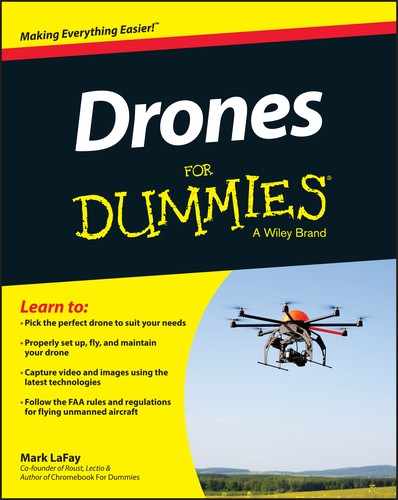
 If you are selecting a camera based on the type of mounts that will work with your drone, you need to make sure that your gimbal and camera will not exceed the drone’s payload maximum. This number is typically listed on the drone’s product spec page on the manufacturer’s website. It will be listed either as payload capacity or take-off weight. For more information on the importance of minding the weight of your camera and mounting equipment, see the next section, “
If you are selecting a camera based on the type of mounts that will work with your drone, you need to make sure that your gimbal and camera will not exceed the drone’s payload maximum. This number is typically listed on the drone’s product spec page on the manufacturer’s website. It will be listed either as payload capacity or take-off weight. For more information on the importance of minding the weight of your camera and mounting equipment, see the next section, “ Lift is what causes heavier-than-air objects to become airborne. Planes achieve lift by moving air over their wings. Rotor-craft, like drones, create lift by moving air over their propellers.
Lift is what causes heavier-than-air objects to become airborne. Planes achieve lift by moving air over their wings. Rotor-craft, like drones, create lift by moving air over their propellers.